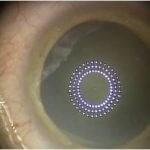Refinements in Cataract Surgery
Richard Erdey, MD has used an intraoperative keratometer for over twenty years to adjust the shape of the cornea to correct astigmatism during cataract surgery and cornea transplantation. Now, Dr. Erdey and his associates, Drs. Searcy and Kaswinkel are using a recently refined intraoperative keratometer, the Mastel Ring Light to improve visual results.
See Richard A. Erdey, MD speak about the use of the Mastel Ring Light to his Ophthalmology colleagues at the ASCRS 2012 national meeting in Chicago: https://youtu.be/9DAO-LhPDvs
This device contains three rings of individual L.E.D.s and a central fixation target.
&srotate=0)
Ring Light mounted on microscope. View as patient sees. Note red fixation light.
Dr. Erdey has found this elegant device has important uses during cataract, corneal, and implantable contact lens surgery.
&srotate=0)
Ring Light: reflection on cornea
He routinely uses it to more accurately align toric intraocular lenses during cataract surgery.
&srotate=0)
Toric IOL perfectly aligned in eye
It also provides valuable real-time intraoperative assessment of residual astigmatism after Scleral Recession, Limbal Relaxing incisions, and Clear Corneal Incisions on axis; and can be used to decide if additional astigmatism reduction is required improving results.
When a red reflex is not needed, he switches off the halogen coaxial light source in the microscope and instead uses the Mastel keratometer as an oblique cool-light source to make it easier for his patients to fixate and to help avoid macula phototoxicity.
When using multifocal intraocular lenses (Restor , Technis multifocal ) centration is important to achieve the best visual performance. Routine use of the ring light as a fixation target allows more accurate centering on the visual axis reducing glare and halos.
Dr Erdey and his associates, Drs. Searcy and Kaswinkel find the The Mastel Ring light an essential tool. The device is now in routine use on each of the microscopes in our two operating suites at The East Columbus Surgery Center.